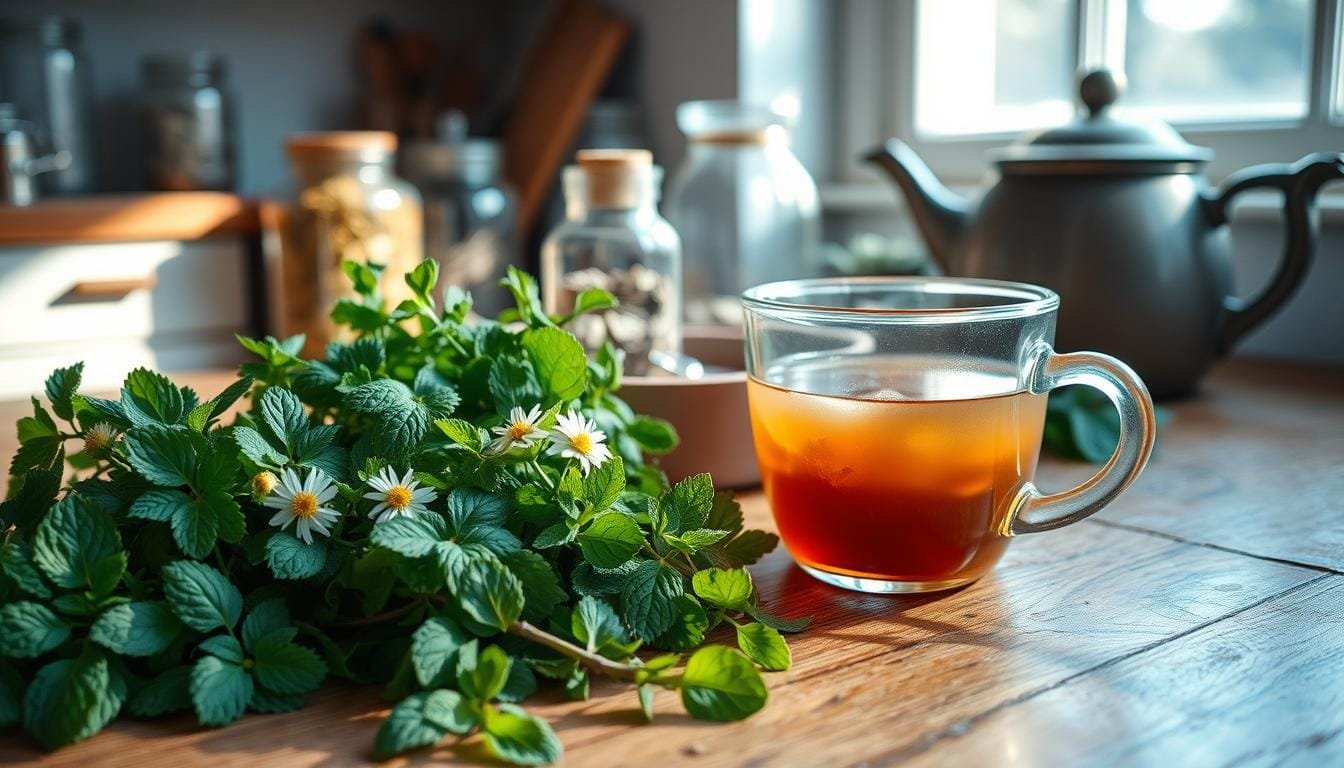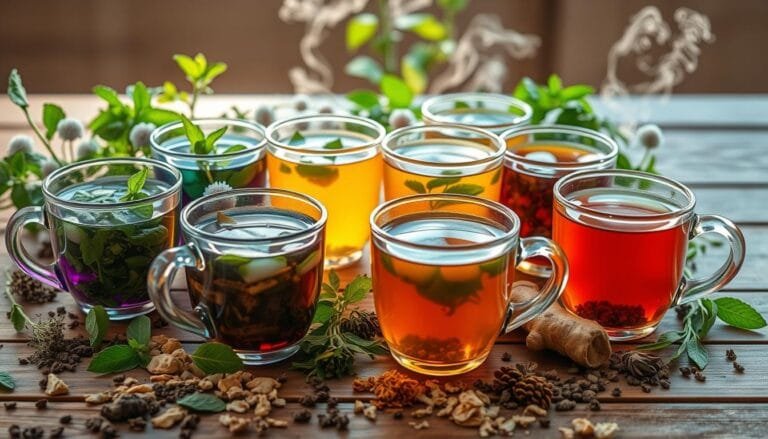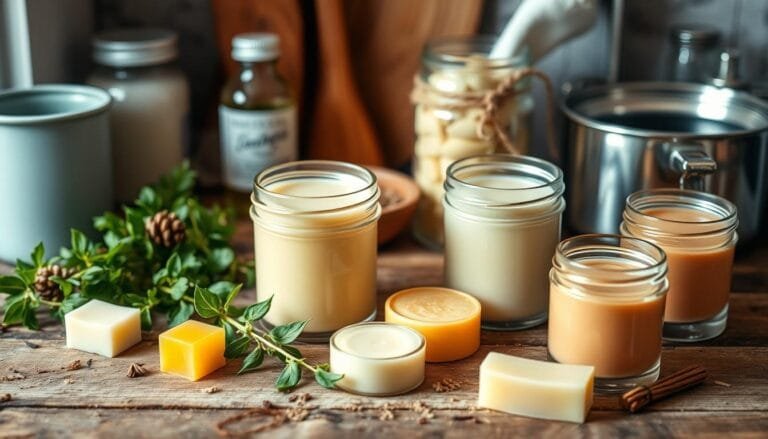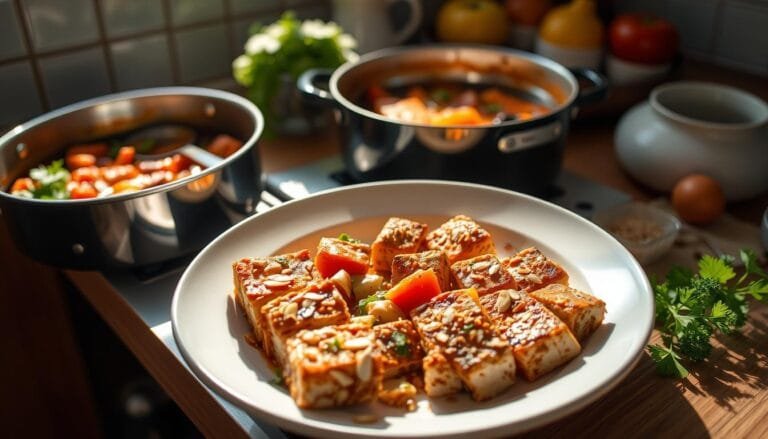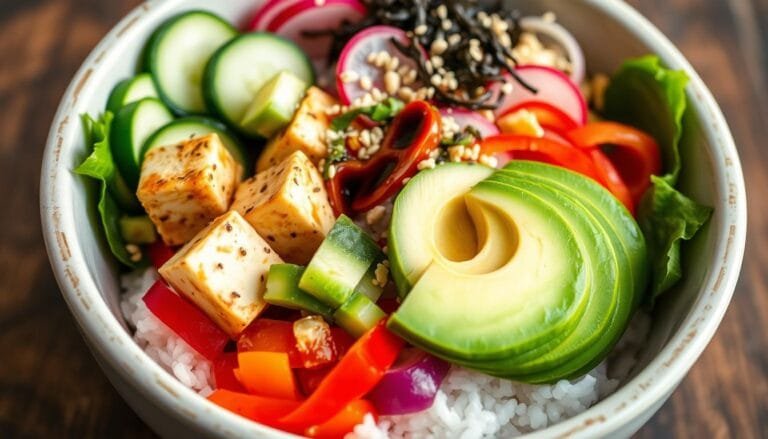I’m passionate about natural wellness, and I’ve found that homemade herbal teas are amazing. They’re not just tasty; they also give you important nutrients. Plus, they don’t have caffeine or pesticides like non-organic coffee does. With so many herbal tea mixes out there, you can make your own special blends.
In this guide, we’ll explore the health perks of herbal teas. I’ll show you how to make them at home and share tasty recipes for any time. Making your own herbal teas can save you money and connect you with nature. It’s a way to take control of your wellness journey.
Looking to boost your immune system or calm a stomach issue? This guide has you covered. You’ll learn how to make herbal tea blends that fit your wellness needs. Let’s start making easy homemade herbal teas for a healthier life.
Understanding the Health Benefits of Herbal Teas
Herbal teas are known for their health benefits. They are not just tasty but also good for you. They can boost your immune system, help with digestion, and reduce stress.
Antioxidant Properties and Immune Support
Many herbal teas are full of antioxidants. These fight off harmful free radicals and protect cells. Rooibos tea, for example, is rich in antioxidants and doesn’t have caffeine.
Rose hip tea, made from rose fruits, is packed with vitamin C. This vitamin is great for a strong immune system.
Digestive Health Advantages
Herbal teas are good for your digestive health. Peppermint tea can help with an upset stomach. Ginger tea is known to ease nausea and help with digestion.
Oregano tea is used for stomach issues and sore throats. It’s a natural remedy.
Stress Relief and Relaxation Benefits
Herbal teas also help with mental health. They can reduce stress and help you relax. Chamomile tea is known for its calming effects and improving sleep.
Valerian tea is also calming, but pregnant women should be careful with it.
“Herbal teas can be a simple and natural way to support overall health and well-being.”
Herbal teas offer many health benefits. Adding them to your daily routine can support your body and mind. They are a natural way to improve your overall wellness.
Essential Equipment for Making Homemade Herbal Teas
Making homemade herbal teas is easy with the right tools. First, you need a good tea strainer or tea ball. These tools help steep your herbs and add flavor to your water. They also make it simple to remove the herbs after brewing, giving you a clean tea.
For storing your dried herbs and tea blends, use glass jars with tight lids. This keeps your ingredients fresh and potent. It also protects them from light, air, and moisture. Airtight glass containers are perfect for this.
| Essential Equipment | Key Benefits |
|---|---|
| Tea Strainer or Tea Ball | Easily infuses water, removes herbs after brewing |
| Glass Jars with Tight-Fitting Lids | Preserves freshness and potency of dried herbs and tea blends |
| Airtight Glass Containers | Protects ingredients from light, air, and moisture |
With these basic tools, you can make delicious herbal teas at home. Enjoy blending and sipping your own special teas!
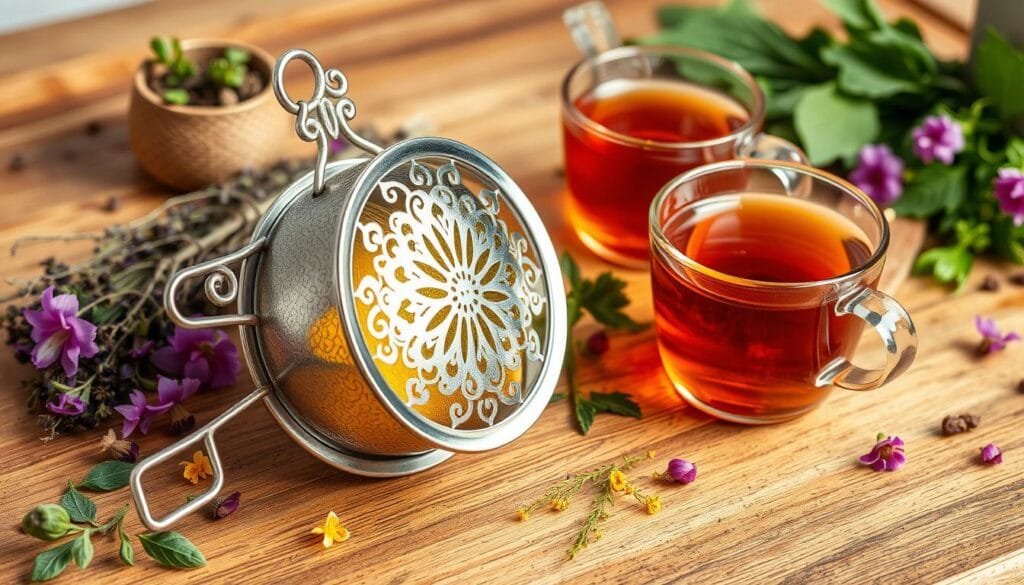
Basic Principles of Crafting Perfect Herbal Tea Blends
Making great homemade herbal tea blends needs a few key steps. You must know the right water temperature, steeping time, and herb-to-water ratio. Learning these basics lets you bring out the best in your herbs and make teas that you love.
Proper Water Temperature Guidelines
The water’s temperature is key for getting the most flavor and health benefits from your herbs. Always boil the water, then let it cool a bit before pouring it over your herbs. This keeps the water hot enough to extract the good stuff without burning the herbs.
Steeping Time Recommendations
Herbal teas usually need to steep for 10 to 15 minutes. This long time lets the herbs release their oils, vitamins, and other good stuff into the water. But, some herbs like chamomile or lemon balm might need only 5 to 8 minutes to avoid bitterness.
Herb-to-Water Ratios
For the perfect herbal tea, use 2 to 3 teaspoons of fresh or dried herbs for every 8-ounce cup of water. This ratio makes sure your tea is flavorful but not too strong. You can tweak the amount of herbs to suit your taste, starting with less for a milder flavor and more for a stronger one.
By following these basic steps, you’ll make amazing homemade herbal tea blends. These teas will not only be good for you but also a joy to drink.
Popular Base Herbs for Homemade Herbal Teas
Chamomile, peppermint, raspberry leaf, and lavender are top picks for homemade herbal teas. They bring wellness benefits and flavor to your tea. Let’s dive into how these ingredients can enhance your tea experience.
Chamomile is known for its calming effects and sweet aroma. It’s perfect for a soothing tea. Peppermint, with its refreshing taste, helps with digestion.
Raspberry leaf is packed with nutrients, great for women’s health. Lavender offers a calming scent and pairs well with other herbs.
You can mix these base herbs with dried fruits, flower petals, and spices. This way, you can create teas that match your taste and health needs. The world of homemade tea is full of possibilities!
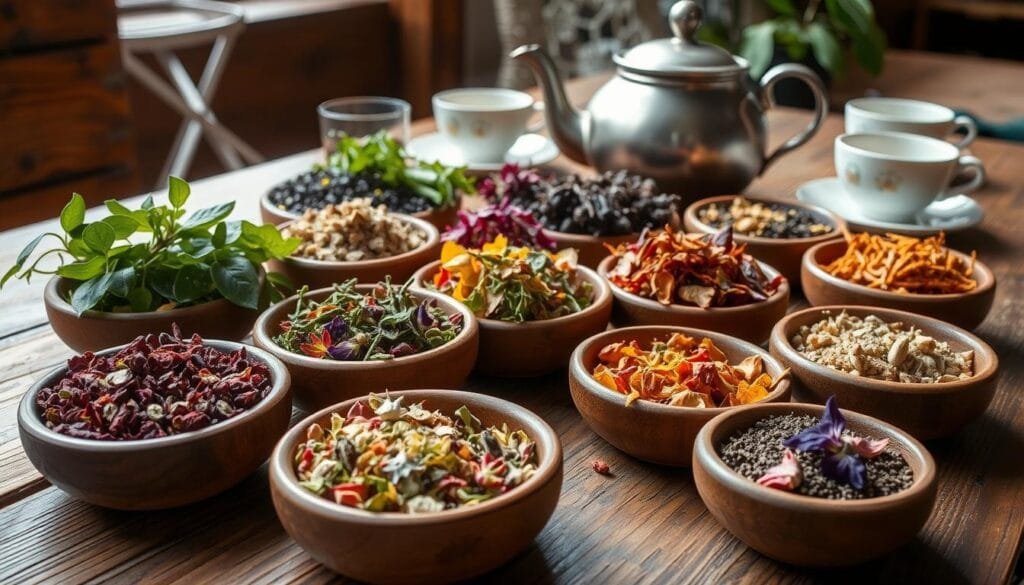
“The secret to a perfectly balanced herbal tea lies in the harmonious blend of base herbs, complementary flavors, and a touch of creativity.”
Creating Calming Bedtime Tea Blends
As the sun sets, it’s time for a soothing cup of herbal tea. These natural infusions are not just delightful but also help with relaxation and sleep. When making the perfect bedtime tea, choose ingredients known for their calming effects.
Chamomile and Lavender Combinations
Chamomile and lavender are a classic duo for bedtime tea. Chamomile soothes anxiety and brings tranquility. Lavender, with its calming floral scent, relaxes the mind. Together, they make a sleep aid that quiets the mind and promotes peaceful sleep.
Sleep-Promoting Herbs Selection
- Passionflower: Traditionally used to treat anxiety and insomnia, passionflower may help increase GABA levels in the brain, leading to a more relaxed state.
- Lemon Balm: This fragrant herb contains rosmarinic acid, which has been shown to have a calming effect and potentially improve sleep quality.
- Catnip: While not just for felines, catnip contains nepetalactone, a compound that may have a soothing and sedative-like effect on humans.
- Valerian Root: Known for its potent sleep-inducing properties, valerian root contains various compounds that can help facilitate deeper, more restful sleep.
By mixing these calming herbs into your homemade relaxation blend, you can make a comforting bedtime tea. It may help you sleep more peacefully.
“Herbal teas have been used for centuries to promote relaxation and support overall well-being. Crafting your own personalized bedtime tea blends can be a wonderfully therapeutic ritual.”
Energizing Morning Tea Recipes
As the morning sun rises, it’s time for a refreshing cup of herbal tea. A well-made morning blend can give you a natural energy boost. This helps you start your day without the jitters coffee can cause. Let’s look at some energizing recipes to get you ready for your day.
One of my favorites mixes peppermint leaf, fresh ginger slices, and yerba mate. Yerba mate, from South America, gently boosts your energy. It does this without the crash that caffeine can cause.
To make this tea, steep 1-2 teaspoons of dried peppermint, a few slices of fresh ginger, and 1 teaspoon of yerba mate in hot water for 5-10 minutes. You can adjust the amounts to your liking. Peppermint refreshes, while ginger’s spice kickstarts your metabolism.
https://www.youtube.com/watch?v=qGl2SevPgTA
For more energy, add a bit of honey or lemon to your tea. Honey sweetens it naturally, and lemon adds a bright citrus flavor.
Drinking this morning blend is a great way to start your day. It makes you feel alert and ready for anything. Try different herbs and spices to find your perfect morning tea.
Digestive Support Tea Combinations
Herbal tea blends can be very helpful for the digestive system. A mix of peppermint and ginger is very effective. Peppermint relaxes the digestive muscles, easing bloating and IBS symptoms. Ginger reduces inflammation and helps with digestion.
Peppermint and Ginger Blends
To make a soothing peppermint and ginger tea, mix dried peppermint leaves with sliced ginger. Steep for 5-10 minutes to get the best flavor and benefits. This mix can ease indigestion, bloating, gas, and cramps.
Natural Digestive Aids
- Lemon balm is good for digestive support, helping with indigestion.
- Fenugreek is full of antioxidants and fiber, reducing acid reflux and toxins.
- Fennel seeds help with gas, bloating, and spasms in the digestive system.
- Dandelion root tea supports liver health and digestion.
Warm or room temperature drinks are better for digestion. They improve circulation in the digestive system. Try different herbal mixes to find what works best for you.
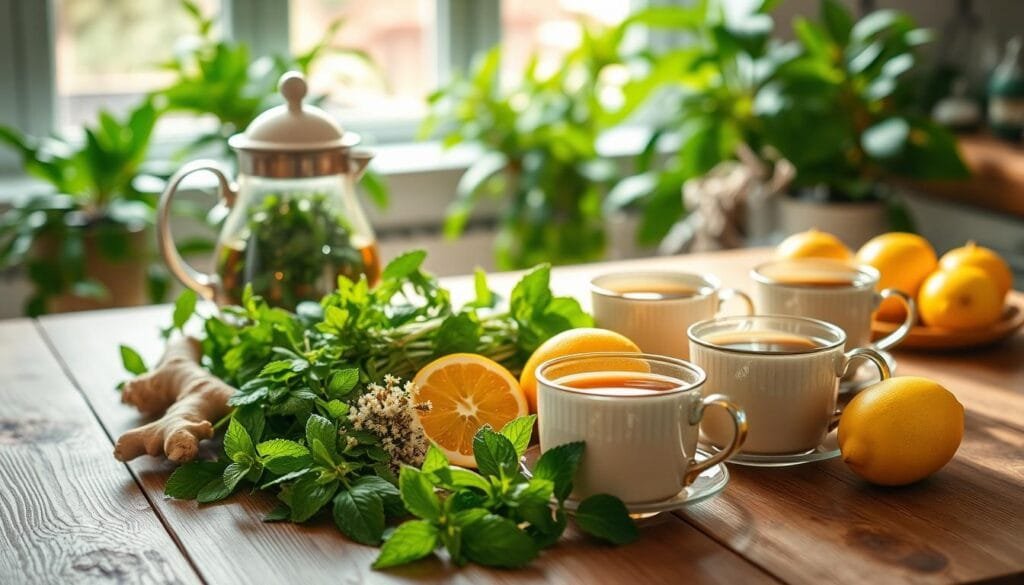
Immune-Boosting Herbal Tea Formulas
Keeping our immune system strong is key to staying healthy. Nature offers many herbs and plants that boost our immune defenses. Making homemade herbal teas is a fun and easy way to use these ingredients.
For a tea that fights off illness, mix dried elderberries, chamomile flowers, rose hips, astragalus, and echinacea. Elderberries can ease flu or cold symptoms. Echinacea and astragalus boost the immune system. Rose hips are full of vitamin C, which is great for fighting off sickness.
This tea is great during cold and flu season or when you’re feeling sick. Drinking it can help keep your immune system strong and support your health.
| Ingredient | Health Benefits |
|---|---|
| Elderberries | May help relieve symptoms of flu or upper respiratory infections |
| Echinacea | Known for its immune-supporting properties |
| Astragalus | Powerful herb used to strengthen immunity over time |
| Rose Hips | Extremely high in vitamin C, a vital nutrient for the immune system |
| Chamomile | Soothing and calming effects, may help reduce inflammation |
Adding these immune-boosting herbs to your tea routine is easy and tasty. It’s a great way to help your body fight off sickness. This herbal tea blend can be a big help in keeping you healthy.
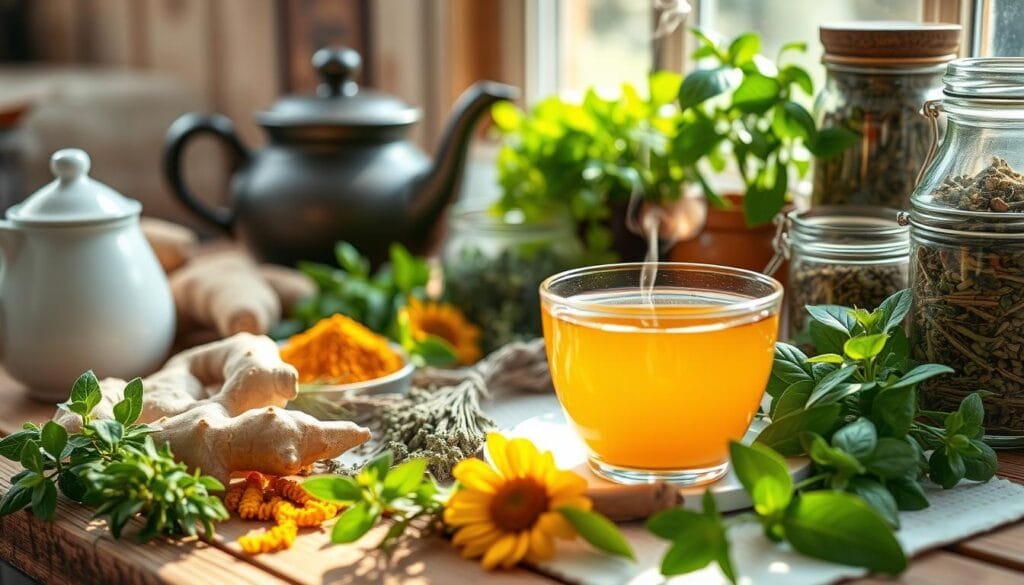
Seasonal Wellness Tea Blends
As the seasons change, our bodies need different things. By changing our herbal tea blends with the weather, we can help our health all year. From cool summer drinks to warm winter teas, making your own herbal teas is a great way to stay healthy.
Summer Cooling Combinations
In the hot summer, teas that cool down are perfect. Mix peppermint, lemon balm, and hibiscus for a refreshing tea. These herbs taste great and are good for you, too.
You can drink these cooling teas hot or cold, as you like. Choose seasonal herbs that help keep your body cool and calm the summer heat.
Winter Warming Recipes
When it gets cold and dark, your body wants something warm and nourishing. Add ginger, cinnamon, and cloves to your teas for warmth. Also, add herbs like elderberries, rose hips, and echinacea to boost your immune system in winter.
Drinking a warm herbal tea is comforting. It warms your body and calms your mind. Try different seasonal herbs and spices to find the perfect blend for you.
Changing your herbal tea blends with the seasons is easy and helpful. Let the natural changes of the seasons guide you. Use your homemade seasonal herbs, cooling teas, and warming blends to keep yourself well.
Proper Storage and Preservation Methods
Keeping homemade herbal teas fresh is key to getting their health benefits. It’s important to store herbs and teas right to keep them potent.
First, make sure your herbs are dry before you store them. Dry herbs prevent mold and mildew. Choose whole herbs for the best flavor and smell. Store them in airtight containers like brown or amber glass bottles. These keep light out and stop bugs and bacteria.
With the right storage, your herbal teas can last up to a year. This keeps them fresh and effective. Always label your containers with the herb’s name, Latin name, and storage date. This helps you keep track of how fresh they are.
| Storage Condition | Importance for Tea Preservation |
|---|---|
| Light | Protects against UV ray degradation |
| Heat | Maintains optimal flavor and aroma |
| Moisture | Prevents mold and mildew growth |
| Odor | Maintains individual flavors and scents |
| Air | Preserves freshness and potency |
For tea preservation, keep herbs in a dark, cool, dry spot. Stay away from strong smells and humidity. Direct light can harm the quality of your teas. Use opaque, food-safe containers to keep them fresh.
By using these herb storage and tea preservation tips, you can enjoy your homemade herbal teas for a long time.
Common Mistakes to Avoid When Making Homemade Herbal Teas
Making homemade herbal tea can be very rewarding. But, it’s key to avoid common mistakes that can ruin the taste and quality. Mistakes like oversteeping and improper storage can turn a healthy tea into a bad cup. Let’s look at the top mistakes to avoid for a great homemade herbal tea experience.
One big mistake is oversteeping. Herbs like chamomile and lemon balm can get bitter if steeped too long. Most herbal teas should steep for 3-5 minutes. So, set a timer and don’t let them steep too long.
Another mistake is using water that’s too hot. While boiling water is good for black or green teas, it can scorch delicate herbs. Use water between 195°F to 205°F for the best flavor.
- Avoid oversteeping, which can lead to a bitter, unpleasant taste.
- Be mindful of water temperature – delicate herbs require slightly cooler water to preserve their flavors.
- Steer clear of storing your dried herbs in plastic containers or areas with high humidity and direct light, as this can degrade their quality over time.
- Resist the temptation to combine too many different herbs in a single blend, as this can result in a muddled, confusing flavor profile.
- Always research the possible interactions and side effects of any herbs you plan to use, specially if you have health issues or are on medication.
By avoiding these common mistakes and following the best brewing and storage practices, you’ll enjoy a wonderful, therapeutic cup every time.
Safe Herb Selection and Possible Contraindications
Exploring homemade herbal teas, I focus on herb safety and possible contraindications. I choose organic or sustainably harvested herbs from trusted sources. Some herbs might interact with medicines or have risks for certain health issues. So, I always check with a healthcare provider before using them for health reasons, if I’m on medication or have health concerns.
For example, some herbs are not safe during pregnancy or breastfeeding. They could risk the health of the mother or baby. I also watch out for herbs that might affect blood clotting or interact with anesthesia if I’m going to have surgery. By getting advice from experts, I can enjoy herbal teas safely and avoid any bad effects.
In the realm of herbal wellness, knowing what you’re doing is key. I aim to make safe and informed choices with the herbs I use in my teas. This way, I can enjoy the natural benefits of these plants without risking my health.
